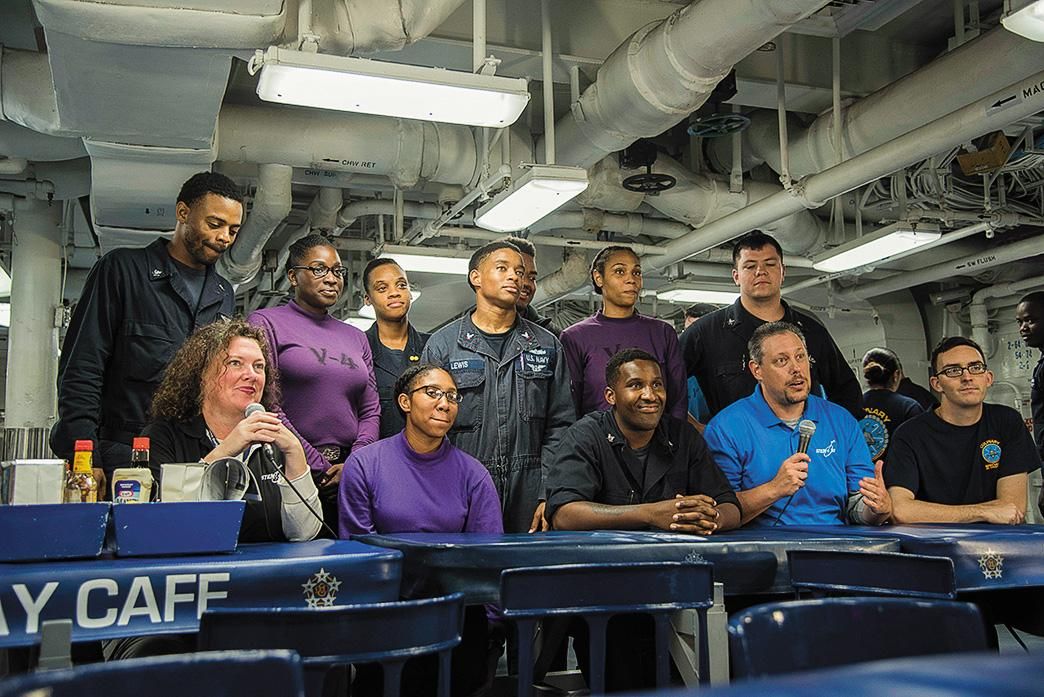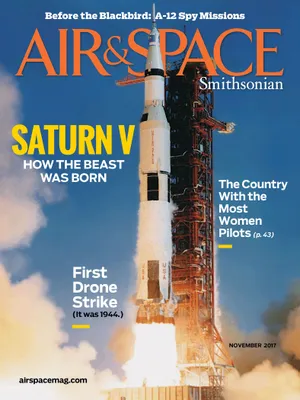Come Along to the Carrier Flight Deck
The “STEM in 30” TV crew goes behind the scenes on the USS Dwight D. Eisenhower.
/https://tf-cmsv2-smithsonianmag-media.s3.amazonaws.com/filer/19/6c/196c942e-abe3-422a-a120-b311edd7d679/01d_on2017_planeandcrew_live.jpg)
On the Grumman C-2 Greyhound, we sat facing backward, wearing life vests, goggles, and helmets. A shouted warning indicated landing was imminent: “Brace yourselves!” The airplane descended and we suddenly jerked backward into our seats. The airplane’s tailhook had attached to one of the four two-inch-thick arresting wires stretching across the flight deck, an ingenious system first used in 1911. We came to a complete stop in two seconds.
The door opened to a panorama of blue ocean and the deck of the USS Dwight D. Eisenhower, cruising in the Atlantic Ocean about 90 miles east of Norfolk, Virginia, on a short training mission. Crew members wearing brightly colored long-sleeve shirts, helmets, and goggles were staring at these civilians blown in from land. We had entered an alternate universe, a world of about 3,000 young sailors from every corner of the country.
Our trip to the aircraft carrier was my opportunity to get a behind-the-scenes look at what goes into creating a National Air and Space Museum educational program called “STEM in 30.” The goal of the 30-minute webcast is to take its primarily middle-school audience beyond the walls of the Museum to places they would ordinarily not have the chance to visit. Since 2014, the program has featured fascinating people who are using STEM (science, technology, engineering, and math) on the job. The spots incorporate history, design, and the arts to demonstrate the role of creativity in innovation. Through a combination of video clips and short live interviews, the webcasts seek to get young students excited about STEM fields.
This trip to the carrier would give the film crew the chance to gather powerful visual images of roaring F/A-18s and sailors at work during the qualifying trials that new pilots were undertaking. It meant several exhausting days for a seven-member crew, including the program’s two hosts, Marty Kelsey and Beth Wilson.
With the help of the ship’s public affairs officers, the film crew planned to explore the entire ship. The program’s producers already had written an outline of the show’s theme: Landing an airplane is difficult under normal circumstances; imagine landing a super-fast fighter on a very short, moving runway. The whole process requires not only math and science, but also the coordination of a massive crew of people. The fighter pilots may get the glory, but they are just the tip of the iceberg. Below the flight deck are thousands of support staff who keep the floating city humming.

Over the next two days we schlepped cameras, tripods, and lights through ten miles of corridors, climbed at least 60 ladders each day, and put protective headgear and ear plugs on countless times. Beth and Marty wanted a powerful opening segment and envisioned an introduction with F/A-18s launching behind them on the flight deck—one of the most dangerous places in the world. The only problem is that noise levels there hinder much talking! Anticipating this challenge, they practiced the segment with only hand motions—and excellent microphones.
We traipsed up to the flight deck for daytime flight operations, for the evening FOD walk (checking for foreign object debris), and then went to Vulture’s Row above the deck for nighttime flight operation filming. We joined the LSOs (landing signal officers) on their platform, where they direct incoming aircraft. We photographed the catapult in action, and shot the two massive anchor chains, each link weighing 365 pounds. Plus we filmed the berthing compartments where Marty and Beth each attempted to wiggle into the middle rack. Among the lessons in math the program will teach is how to calculate a glide slope, an airplane’s optimum angle of approach to landing. The hosts will use the force and motion of the launch catapult to introduce some basic physics.
Over the course of each school year, the Museum produces about 10 STEM in 30 shows, focused on stories that the National Air and Space Museum is uniquely positioned to tell. The STEM in 30 staff consider the iconic objects in the Museum’s collections as well as special guests who have addressed Museum audiences. The programming supports Next Generation science standards, national guidelines developed at the state level and based on National Research Council assessments.
The program has taken students to the Wright brothers’ bicycle shop, the NASCAR Hall of Fame in Charlotte, North Carolina, and NASA Mission Control at the Johnson Space Center in Houston. Producers have also gone behind the scenes at the Smithsonian, to observe technicians preserving the spacesuit collection at the Museum’s conservation laboratory. The producers have interviewed Apollo 11 pilot Michael Collins, master kite builder Jon Burkhart, Tuskegee Airman Charles McGee, and many other aviators. For the carrier show, the hosts interviewed everybody from the commanding officer to the sailors in the mess decks.
As I sat in the C-2 on the return trip, having just been catapulted off the ship to 130 knots (170 mph) in three seconds, I reflected on the ship’s crew. We were all surprised at their youth (average age 23) and impressed with their dedication. They perform very skilled jobs on which people’s lives depend. They trusted us to follow them precisely to keep away from danger, and we trusted them to give us access to the best places and people on the ship to craft a show filled with memorable stories. As with most programs, the biggest challenge will be editing hours of raw footage down to 30 minutes. What stories will we tell? To find out, watch the live webcast on January 24, at 11 a.m. and 1 p.m. Eastern time, at airandspace.si.edu/connect/stem-30.
